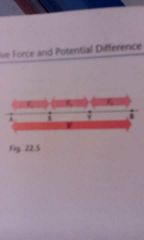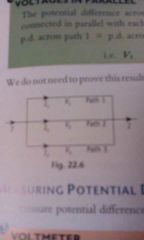![]()
![]()
![]()
Use LEFT and RIGHT arrow keys to navigate between flashcards;
Use UP and DOWN arrow keys to flip the card;
H to show hint;
A reads text to speech;
10 Cards in this Set
- Front
- Back
|
Potential Difference
|
The potential difference between two points in a circuit is the energy lost by one coulomb as it moves from one point to the other.
V=W/Q |
|
|
Unit of potential difference
|
the volt or joule per coulomb
|
|
|
Potential Difference 2
|
It is the amount of energy converted from electrical to other forms between the two points when 1 coulomb of charge passes any point of that circuit
|
|
|
alternate formula
|
P=VI
|
|
|
Voltages in series
|

The potential difference across two or more consecutive parts of a series cir hit is equal to the sum of the potential differences across each part
V=V1+ V2+ V3 |
|
|
Voltages in parallel
|

the potential difference across each of a number of conductors connected in parallel with each other is the same
i.e. V1=V2=V3 |
|
|
Voltmeter
|
A voltmeter is always connected in parallel with the part of the circuit across which the p.d is to be measured
|
|
|
Electromotive Force
|
A volage when applied to a current is called an emf.
|
|
|
Sources of EMF
|
electric cells, simple cell= beaker sulfuric acid and a zinc and copper plate, primary cell cannot be recharged and often called dry cell, secondary cell can be recharged, thermocouple, the mains
|
|
|
Batteries Connected in Series
|
The total voltage is equal to the sum of the individual voltages
|

